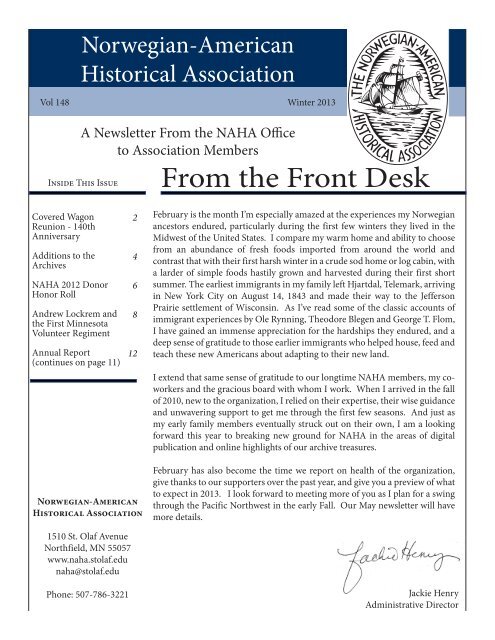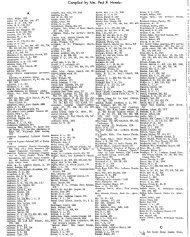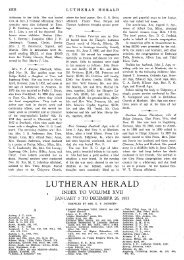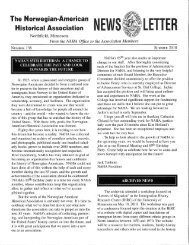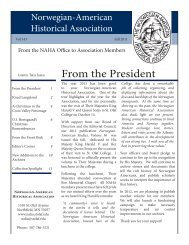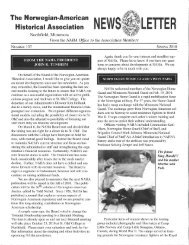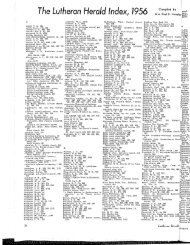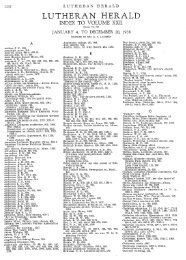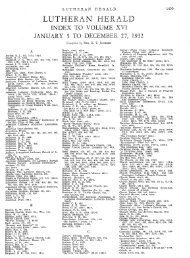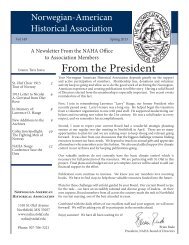Winter 2013 - Norwegian-American Historical Association - St. Olaf ...
Winter 2013 - Norwegian-American Historical Association - St. Olaf ...
Winter 2013 - Norwegian-American Historical Association - St. Olaf ...
Create successful ePaper yourself
Turn your PDF publications into a flip-book with our unique Google optimized e-Paper software.
Page 2Eleven Covered Wagons - 1873On August 9 -11, <strong>2013</strong> an estimated300 descendants of an ElevenCovered Wagon Train will convenein Sioux Falls, South Dakota tocelebrate the 140th Anniversary ofthe original, incredible four weekjourney. It began on May 18, 1873when the Wagon Train left FillmoreCounty Minnesota and headed westinto the sunset to claim land in theDakota Territory. It ended on June18, 1873 upon their arrival in thenortheast corner of MinnehahaCounty, about eight miles westof Garretson, South Dakota. It isbelieved that this Eleven CoveredWagon Train may have been oneof the longest to ever enter Dakotaterritory.Most of the people who comprisedthe Eleven Covered Wagonsstarted emigrating from Norway toAmerica in the mid 1850s, settlingin Wisconsin, Minnesota and Iowa.Their voyage from Norway typicallytook 6 to 8 weeks on ships built tocarry cargo, so accommodations forpassengers were primitive.Anders J. and Caroline O. Berdahl and family circa 1886. From the personalcollection of Solveig Zempel, great-granddaughter. Used with permission.At that time, most of the <strong>Norwegian</strong>immigrants to America traveledthrough Quebec, Canada. However,their journey was far from over asit would take another three weeksto get to their destinations in theMidwest.In the spring of 1871, JohannesBerdahl and several neighborsstarted west to look over the countryand see for themselves what landwas available to be claimed. Whenthey got as far as the Sioux River inDakota Territory near the presentlocation of Brandon, South Dakota,they found what they were lookingfor. The land was good and therewas an abundance of timber sothey turned around and went backto Minnesota, very excited aboutwhat they had seen and found. TheWestern Fever had begun.They returned to the same locationthe following spring, but much totheir dismay, somebody had alreadystaked claim to the land they hadlooked over the year before. Theyconsulted a local surveyor who tookthem to another area further northand east along the Slipup Creek inEdison Township. It looked goodand while it didn’t have timber, itdid have water and hay. The nextmorning they started on a three daytrip to the Vermillion land office tofile their claims.On May 18, 1873, a caravan of 8Covered Wagons departed FillmoreCounty for their new home inDakota Territory. The Wagon Trainstarted with five families: Mr. & Mrs.
The 140th anniversary of the Covered Wagon Journey from FillmoreCounty to Dakota Territory, provided by Ron Halverson.Page 3Johannes Berdahl with 9 children;Mrs. Power (widow) with 6 childrenand her brother-in-law Allen Powerand his son; Mr. & Mrs. JohnLoftesness and their 6 children; Mr.& Mrs. Olaus Jenson and 3 children;Mrs. Lars Branvold and 1 son. Theywere joined a few days later by Mr.& Mrs. Thor Hermanson and his5 daughters and his grandfatherHerman Wangsness and his wifeand youngest son. Mr. WilliamTobin, traveling alone joined thegroup later in the journey.They were now a caravan of 46people with 11 covered wagons, 6horse teams, 5 teams of oxen, alongwith 85 head of cattle, 8 colts, and30 sheep. During the first few daysall of the youngsters got plenty ofexercise by keeping the big herdtogether following the wagon train.Once in the open prairie the cattlewould come along when they sawthe wagons move. In the evenings alarge tent was used as a dining hall,although each family had to providetheir own food.It was a very bad spring for traveldue to heavy rains and flooding.West of Austin, Minnesota they hadto unload all of the wagons and shipgoods by train to Winnebago City.There were days when they were notable to travel more than 6 to 8 miles.The horses proved to be of little useand only the faithful oxen could behitched up as needed to cross themarshy places.Their next challenge was crossingthe Little Sioux River which was soclose to their destination, yet so faraway. The whole valley was underwater with no hope of crossing withtheir loads. Fortunately, they wereable to secure a boat so all of thewagons had to be unloaded againand transferred to the boat. Threeyoungsters were placed on eachside of the boat to prevent it fromtipping. The crossing was difficultand took more than six hours. Oneof the members of the group fellasleep from exhaustion and thatevening the tent was not put up norwas there any attempt at cooking.Fortunately, the rest of the trip wason land that drained better and therewere no more serious encounters ordelays.They reached their destination onJune 18, 1873, a month after theyleft Fillmore County. The actualarrival was a shock as a prairie firehad blazed across the area a few daysearlier, leaving black desolation inevery direction. “Why oh why” saidone of the wives, “did we ever leaveNorway if this is where we must live?Surely God never intended humanbeings to live here.” The first yearswere ones of severe testing. Thegrasshoppers came in clouds anddevoured the crops each of the firstfour years and then the Big Blizzardof 1881 struck, which is still talkedabout.Two of Johannes Berdahl’s sons,Andrew and Erick, each wrotejournals describing the journeyand homesteading in DakotaTerritory. One of Andrew Berdahl’sdaughters, Jennie, married the<strong>Norwegian</strong> novelist, Ole Rolvaag,on the Berdahl Homestead nearGarretson and that house is nowpart of the Heritage Park on thecampus of Augustana College inSioux Falls, South Dakota. In hisclassic pioneer novel, Giants inthe Earth he revealed the humancost of the <strong>American</strong> pioneerexperience. Rolvaag gave muchcredit to his father-in-law anduncle for their writings andstories about the families onEleven Covered Wagons, as hewrote Giants in the Earth. Lettersbetween Rolvaag and the BerdahlFamily are found in archivesthe the <strong>Norwegian</strong>-<strong>American</strong><strong>Historical</strong> <strong>Association</strong> (NAHA)at <strong>St</strong>. <strong>Olaf</strong> College in Northfield,Minnesota.The pioneer beginnings in thiscountry were simple, humbleand fraught with hardshipand privation. Now that thesehardships are partially forgotten,the past seems somewhat moreromantic to us, and the ordealis material for anecdotes. Atthe celebration these, and otherstories, will be shared. Newfriendships will be made andrelationships discovered, all basedon the ancestors we take pride in.They truly were Giants in theEarth.(1) Based on relevant informationcontained in the Autobiography ofErick J Berdahl written about 1928and The Thor Hermanson Familyby Christie Hermanson Monson in1950.
Page 5What We are Reading, Jackie Henryas a chambermaid, nanny, andstore assistant in various townslocated in Benson County, NorthDakota. Of particular interest areseveral photographs taken of staffworkers at the Leeds Hotel, Leeds,North Dakota, ca. 1906. Donatedby Rosanne Bliss.• Photograph Collection,P0655:Alfred C. Jesness glass negativecollection. 138 glass negativesdated between 1886 and 1915, withimage identifications in process.Images of family life in SwanLake Township, <strong>St</strong>evens County,Minnesota, and Fosston, PolkCounty, Minnesota. Donated byLenore Jesness, NAHA member.• Photograph Collection,P0655:Rydholm family collection. 300images (ca. 1860 to 1971) takenprimarily in Boone County,Illinois (depicting Johnson andWange families), and Lee County,Illinois (depicting Williams,Jossendal, and Ullensvangfamilies). A short biographicalnote regarding Wick Williams,Lee County, is included. Donatedby Ralph Williams Rydholm.Vikings Across the Atlantic:Emigration and the Buildign of aGreater Norway, 1860-1945, by DaronW. Olson. Available through theUniversity of Minnestoa Press. $34.95Around the year 1000 a Viking shiplanded on the Atlantic coast of whatwould one day be North America.Nearly a millennium later, on June7, 1945, Norway’s King Haakon VIIreturned from exile under guardof the <strong>American</strong> Ninety-ninth—or“Viking”—Battalion. In Vikings acrossthe Atlantic, Daron W. Olson revealshow these two moments form narrativepoles for the vision of a Greater Norwaythat expanded the boundaries of the<strong>Norwegian</strong> nation.Looking at matters of religion,literature, media, and ethnicity, Olsonexplores how <strong>Norwegian</strong> <strong>American</strong>s’myths about themselves changed overtime in relation to a broader Anglo-<strong>American</strong> culture, while at the sametime influencing and being influencedby the burgeoning national culture oftheir homeland. Beginning in the 1920s,homeland <strong>Norwegian</strong> identity-makersframed the concept of the GreaterNorway, which viewed the <strong>Norwegian</strong>nation as having two halves: <strong>Norwegian</strong>swho resided in the homeland and thosewho had emigrated from Norway,especially those in America. Far frombeing merely symbolic, this idea, Olsonshows, was actually tested by the ordealof World War II, when <strong>Norwegian</strong>sthe world over demonstrated theirwillingness to sacrifice and even die forthe Greater Norway.In its transnational approach, Olson’sbook brings a new perspective toimmigrant studies and theoriesof nationalism; Vikings across theAtlantic depicts the nation as a largercommunity in which membershipis constructed or imagined, a statusof belonging defined not by physicalproximity but through qualities suchas culture and shared traditions.http://www.upress.umn.edu/bookdivision/books/vikings-across-theatlanticWe <strong>St</strong>opped Forgetting: <strong>St</strong>ories fromSámi <strong>American</strong>s, by Ellen MarieJensen. Now in Paperback, 134pp.2012. $24.95During the immigration period of1880-1940 an unknown number ofSámi people left Sápmi (Samiland;“Lapland”) for North Americaalongside Nordic peoples. It has beenestimated that there are at least 30,000descendants of Sámi immigrants inNorth America and most of themare unaware of their Indigenousancestry. The storytellers in this bookgive moving accounts of the historyof their ancestors and tell their ownlife stories of cultural revitalization.They have consciously chosen to stopforgetting their lesser known andsometimes silenced Sámi ancestry byidentifying with a cultural birthright.Further, their stories demonstratea heartfelt commitment to bothhistorical and contemporary Sápmiand the Indigenous world in theirlives.Available from Ingebretsen’sScandinavian Gifts in Minneapolis,www.ingebretsens.com or thepublisher Calliidlagadus, www.calliidlagadus.org.Book descriptions courtesy of therespective publishers.
Page 6Thank you to our members andsupporters for providing the financialresources needed to further ourmission.$1000 and aboveNancy Vaugn Bonser EstateLois DrewsExxonMobileDave Holt+Liv Hustvedt+Adrienne S. and Truxtun MorrisonRazoo FoundationBrian D. Rude+<strong>St</strong>. <strong>Olaf</strong> CollegeLloyd A. SvendsbyeFrank A. Tysver*Solveig Zempel+$500 - $999Karen F. Davidson+Fidelity Charitable Gift FundRev. Richard HalomBonnie C. HarwickDavid HillTrygve LonnebotnBerit T. MesarickJohn Nilson+Jacqueline L. RanbyJudge John R. Tunheim+*$250 - $499Ruth Hanold Crane+ & DouglasCrane, in memory of PaulWoodings and Kristopher PaulsonAnne Ronning DuffCharles E. FishburnFrederick E. GilbertEric W. GreenfeldtKatherine Hanson+*Jackie Henry*Karen Annexstad Humphrey+Alice S. KirnAnn M. LegreidBeverly Nagel*Frieda E. NowlandLee & David RokkeShirley Lillehaugen SantoroFrankie Shackelford+*Donald Wang*2012 Donor Honor Roll$100 - $249AnonymousBarbara L. Bauman*Betty Ann Bergland+Gordon C. BoardmanMichael J. BovreAmy Boxrud+Joan Naglestad BuckleyJohn E. Bye*Ruth Christ, in honor of Helen (Larson)MoeJudith Christensen*Conrad J. Christianson Jr.J. Randolph CoxKaren CranstonPatricia CutshallKristin Dittmann, in memory of Reidarand Chrisma DittmannRobert S. Duxstad*<strong>St</strong>even EdwinsDavid and Clair Elliker-VågsbergJanet K. GeronimeDr. Frederic A. GiereRichard GilmanDennis A. Gimmestad+Robert GranrudHarlan D. GrindeLynn HalversonRhys HansonMary Hargrave †Blaine Hedberg+*Ronald Hendrix*Sonja HillestadPhyllis Holm<strong>St</strong>an HultgrenClair D. HusbyNelson HusebyNorman Johnsen, in memory of Dr.James HillestadJohn Karevoll †Paul Delbert LarsonPhilip C. LarsonDelores Thorson LewisLew LindeValborg Fletre LinnFritjof T. Lokensgard †Joan LosenJohn V. LovellOdd S. LovollJohn MahlumSylvia R. MeagherWilliam C. Melton †Deborah L. MillerElizabeth Paulson Miller, in memory ofKristopher PaulsonHarland S. NelsonRev. Allan O. NelsonCarl NilsenFranklin C. Norman*Magne B. Olson*John M. OphaugHarry and Virginia PapckeGenevieve QuarbergLois M. RandWayne A. RohneBrynhild C. RowbergCynthia Elyce Rubin+Sons of Norway –Kristiania Lodge #47Soglimt Lodge #546Wergeland Lodge #28Donald SahlingLinda SchwartzJoseph M. ShawKaaren Slawson †Dianne Snell*Marilyn & Narve A. SomdahlDr. Allan SortlandTyrone <strong>St</strong>een*Solveig <strong>St</strong>eendal*Judith <strong>St</strong>outlandThrivent Financial for LutheransFoundationRobert R. TollundOle TweetChris VellineNorman Vinnes*Evelyn Ostraat WierengaHans R. WilhelmsenPatricia WilliamsBruce Willis*Meredith Wilson, in memory ofKristopher Paulson$50 - $99Tuck Aaker*Harry H. AndersonR.W. Anderson*George S. Bergh, Jr.Kenneth M. Bergo
Page 7January 1, 2012 through December 31, 2012Grace BirkestolThomas BranigarSarah and J. Ben Buck*Donna Butler*Camilla Cai*Fran Debnam*Andrea EenSherry Einerson*James Ellingboe*Marlene H. EngstromEarl Richard EnsrudMarieth H. EricksonArland O. FiskeRichard Flisrand*Robert M. Fossum*Barbara FreetCheryl Larson Freitag*Tulla K. FroyenRolfe Gjellstad*Christian Hallen*Eric A. Hallen*Joanne A. HarrisJan HaugenLeif Hatlen*<strong>St</strong>even E. Holland*Robert Holum*David JacobsAudrey JohnsonGary M. Johnson*Kirt Johnson*Mitchell K. Johnson*James and Doris JorgensonRuth Kahn*Dr. Roald KindemJoAnn & Richard S. KleberRachel L. Knudsen*Lori Ann Lahlum*Philip P. Larson*Ronald L. Lien*Craig S. Likness*Sharon Loe*Ted Loftness*Zona MathisonBonnie J. McLellan*Todd MoeJohn & Ruth Monson*Jeff Mueller*David Nasby*Barbara NelsonPeggy Norris*Michael I. OfjordMargaret O’LearyLois OlsrudRobert & Ruth Paulson*Julie Pavri*John E. QuamJoel Quie*Barbara Renton*Kek RobienPaul Rood*Walter RuglandCharles Russell*, in memory of EliseWærenskjoldCelia Sawyer*James E. SchlosserNina Schroepfer*Elaine SchulstadKate SeyboldMarvin Slind*Sharyll SmithCurtis Solberg*Allan G. SolomonsonDennis R. SorheimDorothy G. <strong>St</strong>avigHelen <strong>St</strong>eeleKathleen <strong>St</strong>okkerArnold W. ThompsonEdith ThorstenssonMarcia TurcotteKevin Tvedt*Richard TvedtenArlen Twedt*Paul T. VangerudArlen Viste*Joel A. Watne*Under $50Esther E. AlcornMerrill C. AustinJeffrey BarthHoward D. BaumgartPhyllis L. BreddinMarian J. ChristophersonKaren CullenKaren DellerLuther and Vee FjelstadVera Ryen GreggLee E. GrippenJoy A. HallofHoward J. HansenBorg HansonTorild HomstadEvelyn HooverMichael HovlandPhyllis JacobsBernt B. JohnsonCecil JohnsonJames L. JohnsonLowell E. JohnsonDorothy LeonIona Hystad LokenKen MoenckJohn D. MyhreEvelyn NaevestadN. Thomas OlsonJames L. PedersonPeter W. PercyDavid W. PreusSally & <strong>St</strong>eve PundtPhilip J. RamstadMelanie RempleAnn RomoVeron Paul RoodM. Hildegarde SandersonNorris SandvoldLora N. Sanford, in memory ofAndrew JohnsonRichard <strong>St</strong>enersonKenneth <strong>St</strong>ensbyRuth E. <strong>St</strong>randSymra SocietyAllan R. ThoresonLegacy CircleLegacy Circle members haveindicated to us that they have madeprovisions for NAHA in their estateplans. These members are new to theLegacy Circle in 2012:AnonymousBlaine HedbergLillian Thorsness - deceased+ Indicates NAHA Board Member† Indicates Patron Member* Indicates Sustaining Member
Page 8Andrew Lockrem, Sharpshooter, First MinnesotaAndrew LockremAndrew Lockrem was born inNorway on Dec. 22, 1838, andmoved to America with his familyin 1848. His family homesteadedsix miles south of Northfield,Minnesota in an area known asValley Grove.On January 20, 1861, Andrewanswered a recruiting broadside inthe “Northfield Telegraph” for allsuperior marksmen to try out foran elite group of sharpshooters,the First Regiment of United <strong>St</strong>atesSharpshooters, under ColonelHiram Berdan.Hiram Berdan was nationallyfamous for being one of the bestmarksmen in the country. Hepetitioned President Lincoln andCongress to develop a regimentof sharpshooters from all over theUnited <strong>St</strong>ates. Each company ofabout 100 soldiers would be froma different state making this wasone of the first national regiments.Berdan wanted his regiment to beunique. He designed a uniform thathinted at an attempt at camouflage.The first uniforms were light bluetrousers with hunter green frockcoats and caps. The buttons weremade of a hard rubber and didnot shine like brass buttons. Laterversions of this uniform addedgreen trousers and brown leatherleggings.Captain William Russell sent aNorthfield native, Corporal C.R. Eldridge, to test many men inthe area to see if they could passthe exacting test of hitting 10consecutive shots in a red target of20 inches in diameter placed at twohundred yards. Lockrem passedthis test of marksmanship alongwith his two friends and neighborsHalvor Quie and Fingal Fingalson.They all enlisted on January 20,1862. Lockrem was 25 years old.He stood 5’ 10” tall. He had a lightcomplexion, brown eyes and lightcolored hair. Halvor Quie was27 and Fingal Fingalson was theyoungest at 19. One hundred menand three commissioned officersformed “Company L” or “TheSecond Company of MinnesotaSharpshooters”. All but five werefrom Minnesota. Their captain wasCaptain William Russell.The men of “Company L” gatheredat Fort Snelling, Minnesota forsome basic training. In April, 1862,they traveled by train to WashingtonD.C. On May 3, 1862, they leftWashington for Virginia to hook upwith the First Regiment of United<strong>St</strong>ates Sharpshooters who werealready engaged in a Union offensivecalled “The Peninsular Campaign”.The men of “Company L” reportedfor duty to Colonel Berdan on May7, 1862, at his headquarters at CampWinfield Scott.On the afternoon of May 8, 1862,the company received their arms,the Sharps 54 caliber breechloadingrifle. This rifle enabled asoldier to load the rifle from thebreech instead of down the muzzle.A soldier could load the weaponlying down or on the move. TheSharps gave a soldier a greater rateof fire than most muzzle loadingrifles or muskets. On May 12, 1862,they received their first lessonsin company movements and inskirmishing from Captain EdwardDrew of Wisconsin’s Company G.Skirmishing means to go out well infront of the main body of troops toengage the enemy, scout the enemypositions, and test their strength.The sharpshooters would also beused as snipers to harass artillerypositions and enemy pickets, or toslow the enemy’s advance.The goal of the Peninsular Campaignwas to capture Richmond, Virginia,the capital city of the Confederate<strong>St</strong>ates of America. Andrew sawmuch action during this campaignin a series of battles and Unionretreats known as the “Seven Days’Battle” or the “Seven Days’ Retreat”.While in Virginia he participated inthe Battles of Hanover Courthouse,
Page 9Volunteer Infantry Regiment - by Mark DaleyFair Oaks, Savage <strong>St</strong>ation, WhiteOaks Swamp, Malvern Hill, and theevacuation at Harrison’s Landing.On May 30, 1862, Lockrem and“Company L” received an orderto report to The First Regiment ofMinnesota Volunteers. This newswas well received by the men of“Company L” who were proud toserve with their fellow Minnesotans.They joined the First Minnesotaon June 3, 1862, during the Battleof Fair Oaks. From this date untilNovember 23, 1863, the men of“Company L” fought alongside theFirst Minnesota.The Union forces were battledout of Virginia in August of 1862.“Company L” moved north withthe Army of the Potomac to defendWashington DC. This defeat wasvery hard on Union morale. InSeptember of 1862, General RobertE. Lee’s Confederate Army invadedMaryland in the hopes of drawingthe Union Army out of WashingtonDC, destroying it, and forcing theNorthern <strong>St</strong>ates to sue for peace.The Union forces caught up withthe invading Confederates atSharpsburg, Maryland near a creekcalled Antietam.On September 17, 1862, around4:00 a.m. Lockrem, “Company L”,and the First Minnesota “coffeedup” and from a farm they watchedthe Union and Confederate forcesslam into each other at a place called“The Cornfield”. Around 7:00 a.m.the Second Corps under GeneralSumner was called to attack. Themen crossed Antietam Creek andthe 5000 men of General Sedgwick’sdivision formed into three lineswith a brigade in each line. The FirstMinnesota was placed in GeneralGorman’s front line holding theright of the line. “Company L” wason the left of the First Minnesota.As they passed a grove of treescalled “The East Woods” they weregreeted with a most horrific sight.Thousands of Confederate andUnion dead and wounded troopswere lying on the field so thick itwas hard to march without steppingon the victims of that morning’sslaughter. “The Cornfield” was soshot up that the corn stalks lookedas though they had been cut with aknife. The ground was soaked withblood and formed a foul mud on theshoes of Andrew and the 5000 menwho marched shoulder to shoulderacross this field. The pleas of thewounded begging for water or askingto not be stepped on filled their ears.Groups of exhausted Union troopsfrom the morning’s battle cheeredon the Union advance.As they crossed the field the Unionline started to experience thefirst artillery barrage of solid andcanister shot. The Confederateforces under General Thomas“<strong>St</strong>onewall” Jackson opened fire onthe advancing Union troops froma grove of trees called “The WestWoods”. The Union line enteredthe woods and exchanged fire withJackson’s men for about an hour.General Sumner was confident thathis Second Corps could merelysweep around the Confederate leftand encircle these troops. He wassurprised when the ConfederateArmy flanked his left and pouredfire into his line. This started amassive panic and retreat of theUnion forces.When the regiment to the leftof “Company L” gave way Capt.Russell thought there was ageneral order to retreat and heordered “Company L” to begin towithdraw from the line. When hewas told to return to the line, heordered his men to do so and theycoolly returned to their untenableposition and resumed fire. It wasat this point in the battle that“Company L” received almost 50%casualties. Lockrem’s friends andneighbors went down around him.Halvor Quie was shot through theleft heel and was forced to limpfrom the field. Fingal Fingalsonwas shot and seriously woundedin the left arm forcing his rifle todrop and his arm to hang uselessly.Leaving the battle line for therear, he met Captain Russell whoordered him back into the line.The wounded Fingal raised historn and bleeding arm with hisother hand and said, ”You take myplace now Captain.”“Humph!” snorted the Captain;“You better go and report to thesick squad.”“Exactly where I was headed for.”Fingalson answered.Lockrem was shot twice in theleft thigh. One bullet went cleanContinued on Page 10
Page 10Lockrem and the First Minnesota - continuedthrough but the other lodged inhis flesh. He went down and couldnot get up. He watched helplesslyas Colonel Sully finally orderedthe gallant First Minnesota towithdraw from the field. It wasat that time, that Lockrem wascaptured and taken prisoner bythe Confederate forces.One can only imagine thenightmare of a Confederate fieldhospital during and after theBattle of Antietam. It was thesingle bloodiest day of fightingin <strong>American</strong> history. It was amiracle that Lockrem survived theexperience with his leg intact. Hewas freed in a prisoner exchangea few days after the battle whenGeneral Lee and the ConfederateArmy retreated across thePotomac River to Virginia.On Oct. 11, 1862, Lockrem wasparoled at the School HouseHospital in Chambersburg,Fingal FingalsonPennsylvania. While there hereceived a letter from his fiancee,Anna Halverson. In the letter sheplaced a lock of her hair fashionedinto a watch fob. She also told himabout the Minnesota Massacrein which hundreds of Minnesotasettlers were killed when the DakotaIndians led one of the largestuprisings in <strong>American</strong> history.Lockrem was discharged fordisability and mustered out of theArmy on February 25, 1863. Hereturned to Northfield, Minnesotato his family and his beloved Anna.They were married on May 17, 1864,and together raised a large family ofseven children.In 1882, Andrew, Anna, and theirchildren moved to North Dakota’sRed River Valley. They homesteadednorth of Park River, North Dakotaalong the middle branch of the ParkRiver. These pioneers lived, loved,and eventually died there. Anna diedin 1908 and Andrew died on July 20,1910. They were founding membersof the Park Center Church wherethey are buried in that church’scemetery.Note: Fingal Fingalson was woundedin the leg at the Battle of HanoverCourthouse but returned to the line.He later suffered a sunstroke whichcaused him to faint and experiencememory loss. After his woundsat the Battle of Antietam, FingalFingalson was sent to the Ladies’Hospital in New York City to recoverfor nine months. This hospital wasalso referred as the New York ArmyHospital. While recovering he wasordered to help stop the “NewYork City Draft Riots” that wereso deadly and destructive. He waslater promoted to sergeant andmustered out of the service onApril 27,1865. Fingal returned toNorthfield and married AndrewLockrem’s sister Malina. Theylater homesteaded in BeckerCounty near the town of Calloway,Minnesota. They raised a largefamily. Malina died in 1891 andFingal died in 1930.Halvor Quie was sent to recoverfrom his horrible heel woundin Annapolis, Maryland. Hewas discharged for disability onJanuary 8,1863.Quie returned to Northfield,Minnesota and married AnnaFinseth in 1865. They lived in theValley Grove community six milessouth of Northfield. They alsoraised a large family. Quie died in1919. He and Anna were buriedin cemetery at the Valley GroveChurch.According to their militaryrecords all three of these brave andhonorable men suffered greatlyfor the rest of their lives due to theterrible wounds they received atAntietam.About the author: Mark Daley is ahigh school history teacher in SantaFe, New Mexico. This article firstappeared in the Northfield News,on September 18, 2012. The articleand photographs are reprinted withpermission of the author.
Page 11NAHA Annual Report - Continued$160,000.00$140,000.00$120,000.00$100,000.00$80,000.00$60,000.00$40,000.00$20,000.00$-Operations Revenue Sources 2012-20102012 2011 2010All other sourcesDraw From InvestmentIncomeGrantsMembership DuesDonationsInvestment Fund Balances as ofDecember 31, 2012O.E. Rolvaag Memorial $874,477Fund (Endowed Fund forOperations)Theodore C. Blegen $364,440Fellowship Fund(Editor’s fund)Sigvald Quale $207,799<strong>Norwegian</strong>Society Fund$120,000.00$100,000.00$80,000.00$60,000.00$40,000.00$20,000.00$-$60,000.00$50,000.00$40,000.00$30,000.00$20,000.00$10,000.00$-Non-publication expenses 2012-20102012 2011 2010Publication Expenses 2012-20112012 2011SalariesAdministrative and OfficeExpensesSoftware andSubscriptionsMeetings and EventsNewslettersAccounting and InsuranceEditing/Copy/LayoutMailingPrintingOperating and $282,721Temporarily RestrictedFundsInvestment Income for 2012Realized Gains $73,086Interest and $31,842DividendsUnrealized gains $180,810(losses)Reporting on archive activities,membership and outreachactivities will be included withthe May <strong>2013</strong> newsletter.The mission of the <strong>Norwegian</strong>-<strong>American</strong> <strong>Historical</strong> <strong>Association</strong>is to locate, collect, preserveand interpret the <strong>Norwegian</strong>-<strong>American</strong> immigrant experiencewith accurace, integrityand liviliness. In doing so,<strong>Norwegian</strong> <strong>American</strong>s willhave an indentifiable positionin America’s past, present andfuture.
<strong>Norwegian</strong>-<strong>American</strong><strong>Historical</strong> <strong>Association</strong>1510 <strong>St</strong>. <strong>Olaf</strong> AvenueNorthfield, MN 55057NON-PROFIT ORG.U.S. POSTAGE PAIDFARIBAULT, MNPERMIT NO. 21www.naha.stolaf.edunaha@stolaf.eduPhone: 507-786-3221Change Service RequestedAnnual Report of the <strong>Norwegian</strong> <strong>American</strong> <strong>Historical</strong> <strong>Association</strong>Highlights from 2012• April gathering of NAHA members in New York City at the residence of Consul General Sissel Breie withspecial presentation by author Siri Hustvedt.• Presentations at the Bygdelagenes Fellesraad Annual Meeting, Mindekirken Tuesday program, Tre Lag<strong>St</strong>evne and Sons of Norway monthly meeting in Cedar Falls.• October publication and launch of From America to Norway: <strong>Norwegian</strong>-<strong>American</strong> Immigrant Letters,1838-1914, Volume One.• Biennial meeting in October 2012 featuring Michael and Bonnie Jorgensen and their presentation on<strong>Norwegian</strong>-<strong>American</strong> composer, teacher and performer Theodora Cormontan.Plans for <strong>2013</strong>• <strong>Norwegian</strong> Heritage Day at <strong>St</strong>. <strong>Olaf</strong> College on Tuesday, May 7, <strong>2013</strong>. Featuring Eric Dregne as keynotespeaker. Watch your mail for a save-the-date postcard with registration details.• Re-release of Theodore Blegen’s 1936 book The Civil War Letters of Colonel Hans Christian Heg ine-book and print-on-demand (anticipated completion by September <strong>2013</strong>, in commemoration of the150th anniversary of the Battle of Chickamauga where Col. Heg was fatally wounded).• Meet and greet events in the Pacific Northwest (currently being arranged - again, look for information infuture mailings).Continued on Page 11


